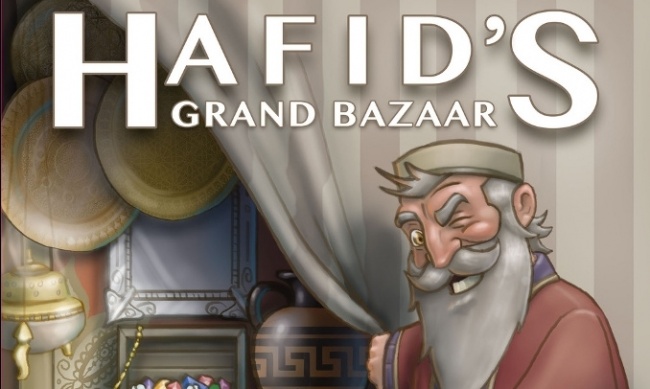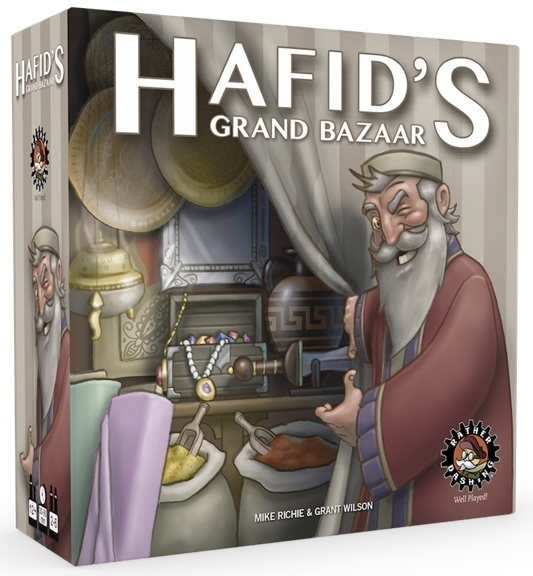Hafid's Grand Bazaar
Publisher: Rather Dashing Games
Release Date: September 2017
Price: $34.99
Game Designer: Mike Richie
Artist: Grant Wilson
Format: Board Game
Number of Players: 2 to 6
Playing Time: 30 to 90 minutes
Product #: RDG704003
Age Rating: 12 and up
ICv2 Rating: 3 Stars out of 5
It seems that, of all the themes for games, the exotic trading bazaars of the Middle East hold special appeal. There is something about the nitty-gritty of haggling and trade that makes it a natural for board games. But as the saying goes, buyer beware, for not every haggling game is worthy. Does Hafid’s Grand Bazaar make an offer that’s too good to be true?
Summary: Players are merchants hoping to entice three well-heeled buyers into handing over their valuable Talents in exchange for sets of goods cards. Each card shows one specific good, such as spices or goats, as well as a type of goods, such as food or livestock. Each buyer demands certain combinations of goods, either collections of identical goods, a good of every type, or every variety of goods of the same type.
Cards showing goods are dealt out every round, but most of the time players gain their goods by bidding on the six caravans that arrive each round, or by hiring “free traders” who will give them random goods. As a result, the heart of the game is the bidding phase, where players assign their six bidding cubes to the caravans, the buyers, or influential people at the bazaar. Players can compete for some items—only one player can claim the Informant or a given caravan, for instance—while others merely have to have a single cube assigned to them for use. If a player bid on the Negotiator, a trading phase follows, but every trade must involve a player who bid on the Negotiator. Finally, the round ends when players sell their goods to the buyers that they placed bid cubes on.
Originality: What makes Hafid’s Grand Bazaar interesting is the variety of skills that a player will need to call upon in order to prevail. Bidding skill is needed, of course, as well as some negotiation during the trading phase, the ever-popular set collection, and a shrewd sense of which buyers to commit bidding cubes to. One particular feature I rather like is the fact that the backs of the cards communicate the type of good represented, while the specific identity of the good is hidden. So, you might see that I’m collecting livestock, but you have no way to know if I have the horse you’re looking for, or just another goat.
Presentation: I have long been a fan of Wilson’s illustrations. The style is a bit cartoony, perhaps, but it’s light-hearted and fun and fits the play style and theme of the game very nicely. A winking Hafid giving a peek at his wares dominates the cover of the box, giving the audience a good idea what the game is about. The titles and graphics are very clean and easy to read, and the back of the box gives a good brief description and a nice picture of the components. I have always found the presentation of Rather Dashing’s titles to be nicely done, and Hafid’s is no exception here.
Quality: Component quality is, alas, a bit of a mixed bag. The box is strong, and sturdy. The insert is excellent, with a handy bin for every type of component and ample storage. The tiles are thick and weighty, and the cards are good quality (though you’ll shuffle them a lot, so I’d recommend sleeves—fortunately plenty of space for those in the box, too). The game board is small, but functional once you get it to lie flat.
On the other hand, I was disappointed by the bidding cubes. I can’t help but feel that simple wooden cubes are a bit passé nowadays. I would have liked to see something more thematic (camels, maybe?), not to mention something easier to handle than tiny wooden squares. But my big beef is with the rulebook, and I have to say that this is a huge surprise. Rather Dashing usually presents excellent rulebooks, clear and easy to follow. But even after multiple readings and playing a full game, we still found ourselves with unanswered questions. Nothing so serious that it could not be hashed out in polite discussion, but still a disappointing surprise.
Marketability: Rather Dashing has been quietly building their brand for some time, specializing in light, family-friendly games that are easy to learn, quick-playing, and fun. Hafid’s Grand Bazaar will certainly appeal to that audience. The $35 price tag feels a bit high, but the game does offer good heft for its size thanks to the big deck of cards. It’s a good choice for casual game night, and fits that market well.
Overall: When I saw Hafid’s Grand Bazaar, I envisioned a cutthroat game of fierce haggling and negotiating. What I found was much more relaxed, fun, and casual. Once we worked out the wrinkles in the rules, we had a good time playing, but I couldn’t help but feel that something was still missing. I wanted more direct interaction and negotiation between the players, but that was dependent on someone being willing to commit one-sixth of their resources for a round to the Negotiator, and truthfully more than one player would have to do so for the negotiation phase to really sing. Perhaps things would have been more tense with more players, but our group never felt that there was a shortage of stuff, so we rarely had bidding wars.
It’s not that I found Hafid’s Grand Bazaar disappointing. It is fun to play and it has enough meat to it to offer some challenging decisions, once you understand the rules and play it aggressively. That’s why I’m giving this game 3 out of 5.
-- William Niebling

ICv2 Stars: 3 (out of 5)
Posted by William Niebling on October 31, 2017 @ 3:58 am CT



